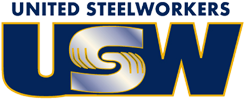You are here
About Us
United Steelworkers Local 351L represents around 1160 workers at the B.F. Goodrich Tire Plant in Tuscaloosa, Alabama. The local has come a long way since it was first chartered as United Rubber Workers Local 351 on April 7, 1947. Local 351 started with 225 members and was the first Congress of Industrial Organizations local in this area. At that time most labor unions in this part of Alabama were associated with the American Federation of Labor.URW Local 351 rented office space in the Masonic Building and the top floor of the Hill Grocery Company for their meetings. Both buildings were located on Sixth Street in downtown Tuscaloosa, Alabama. The first officers of Local 351 were Rudolph A. White, President; Jack W. Suther, Vice President; W. L. Hayes, Secretary.
In 1951 our local purchased property just south of Tuscaloosa, Alabama on US Highway 11 also known as Culver Road. The local constructed a building for membership meetings on the property that is near the plant entrance. This building is still used today and after numerous additions and expansions the building has space for offices, a conference room, auditorium, kitchen and recreation room. That recreation room was used in September 1951 to start the B.F. Goodrich Employees Federal Credit Union.
On July 12, 1995, the United Rubber Workers International Union and the United Steelworkers of America merged and the local became United Steelworkers of America Local 351L. On April 12, 2005 the United Steelworkers of America International Union and the Paper, Allied-Industrial, Chemical and Energy Workers International Union merged and we became the United Steelworkers Local 351L.
The Congress of Industrial Organizations (CIO) was the brainchild of John L. Lewis and leaders of seven other unions--Charles Howard, International Typographical Union; Sidney Hillman, Amalgamated Clothing Workers; David Dubinsky, International Ladies' Garment Workers; Thomas McMahon, United Textile workers; Harvey Fremming, Oil Field, Gas Well and Refinery Workers; Max Zaritsky, United Hatters, Cap and Millinery Workers; Thomas Brown, International Mine, Mill and Smelter Workers. They formed the Committee for Industrial Organization, which initially was contemplated as a part of the American Federation of Labor (AFL), but became an independent organization in 1936, when the AFL Executive Council voted to expel the unions involved with the CIO. After the AFL convention formally revoked the CIO unions' charters, the Committee became the Congress of Industrial Organizations in 1938.
The CIO's goal was to organize America's industrial workers in the steel, auto, electrical, rubber, glass, textile, and other mass production industries. Said John L. Lewis upon the CIO's creation:
"The millions of workers in our mass production industries have a right to membership in effective labor organizations and to the enjoyment of industrial freedom. They are entitled to a place in the American economic sunlight. If the labor movement and American democracy are to endure, these workers should have the opportunity to support their families under conditions of health, decency, and comfort, to own their own home, to educate their children, and possess sufficient leisure to take part in wholesome social and political activities."
The CIO was extremely successful. By 1937, Lewis was able to report to the first CIO Conference that the United Auto Workers had grown almost overnight to 400,000 members and the United Steelworkers to nearly 500,000 members. Altogether, the CIO had organized nearly 4 million workers into 32 national and international unions in less than two years. Over 30,000 companies signed contracts with CIO unions, resulting in wage increases in excess of $1 billion, shorter work hours for millions of workers and improved working conditions. The CIO was fulfilling its pledge to bring workers into the "American economic sunlight."
Source: umwa.org
